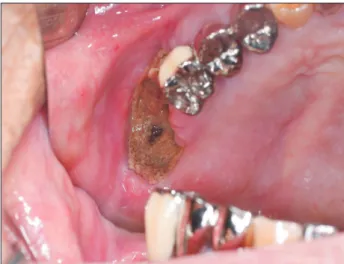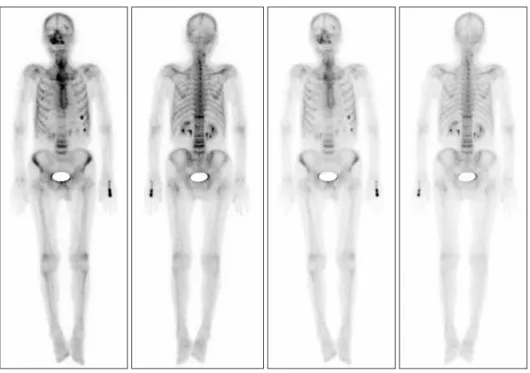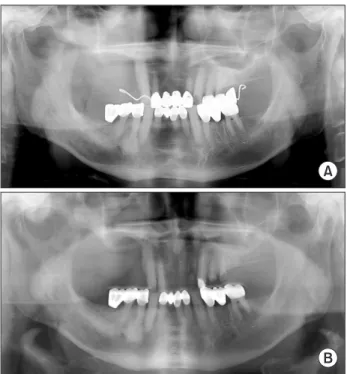BRONJ occurs more frequently in females, there are cases of BRONJ occurring in males as well. These are mainly related to a history of malignancy, multiple myeloma, and osteopo- rosis which occurs as a result of aging3.
II. Case Report
A male patient in his late eighties visited our department from a local clinic for treatment of osteonecrotic lesions of the right posterior maxillary region. He had undergone a tooth extraction (the first right upper molar) at a local clinic three years ago. The sequestrum was exposed through the unhealed extraction wound with purulent discharge. The sur- rounding soft tissue showed erythematous and edematous gingiva.(Fig. 1)
The patient’s medical history revealed that he had a orchi- ectomy to remove diffuse large B cell lymphoma from his testicles followed by chemotherapy and radiation therapy to his para-aortic lymph nodes and pelvic region six years prior.
Two years after the cancer treatments, he was diagnosed with osteoporosis and took alendronate (Fosamax Tab. 70 mg;
MSD Korea, Seoul, Korea) once a week until visiting our department. At the time of osteoporosis diagnosis, his bone mineral density T-score was –2.7.
I. Introduction
In Korea, the number of cases of bisphosphonate-related osteonecrosis of the jaw (BRONJ) occurring in female pa- tients as a result of dental treatment following medication for postmenopausal osteoporosis has been recently increas- ing1. The American Association of Oral and Maxillofacial Surgeons (AAOMS) define BRONJ as medication-related osteonecrosis of the jaw in cases where antiresorptive or an- tiangiogenic agents have been administered, continuous bone exposure in the maxillofacial area for a period of more than eight weeks has been confirmed, and radiation therapy of the maxillofacial area has not been performed2. The AAOMS also describe treatment methods according to the classifi- cations determined by the patient’s symptoms2. Although
Yong-Dae Kwon
Department of Oral and Maxillofacial Surgery, Kyung Hee University Dental Hospital, 23 Kyungheedae-ro, Dongdaemun-gu, Seoul 02447, Korea
TEL: +82-2-958-9360 FAX: +82-2-966-4572 E-mail: yongdae.kwon@gmail.com
ORCID: http://orcid.org/0000-0001-9620-4814
This is an open-access article distributed under the terms of the Creative Commons Attribution Non-Commercial License (http://creativecommons.org/licenses/by-nc/4.0/), which permits unrestricted non-commercial use, distribution, and reproduction in any medium, provided the original work is properly cited.
CC
Bisphosphonate-related osteonecrosis of the jaw in a patient with osteoporosis following treatment of testicular cancer: a case report
Do-Sup Kim, Jung-Ho Kim, Joo-Young Ohe, Jung-Woo Lee, Byung-Jun Choi, Baek-Soo Lee, Yong-Dae Kwon Department of Oral and Maxillofacial Surgery, Kyung Hee University School of Dentistry, Seoul, Korea
Abstract(J Korean Assoc Oral Maxillofac Surg 2015;41:327-331)
Bisphosphonate-related osteonecrosis of the jaw (BRONJ) occurs mainly in female patients. In males the occurrence rate is low, which seems to be related to the low incidence of osteoporosis in men. Unfortunately, BRONJ tends to be ignored in general dental clinics in male patients with a history of osteoporosis treatment. BRONJ occurred in a male patient due to the clinician’s lack of interest in the patient’s history. In this case, the male patient was on bisphosphonate therapy because of a orchiectomy, and a dental treatment was performed without consideration of his medical history, resulting in BRONJ. We performed careful examinations and treatment with antibiotics and surgical operations. The postoperative healing was successful. In light of this particular case, we concluded that careful listening to the patient’s history is very important.
Key words: Bisphosphonate-related osteonecrosis of the jaw, Osteoporosis, Orchiectomy
[paper submitted 2015. 5. 4 / revised 2015. 6. 16 / accepted 2015. 7. 12]
Copyright Ⓒ 2015 The Korean Association of Oral and Maxillofacial Surgeons. All rights reserved.
This research was supported by a grant from the Korean Health Technology R&D project through the KHIDI, funded by the Ministry of Health &
Welfare, Republic of Korea (HI14C1812).
Upon a radiologic study, we found sequestrum formation in the #16 area, which had a well-defined margin, making it easily distinguishable4. The region extended beyond the al- veolar bone into the right maxillary sinus (Fig. 2), and a bone scan image showed increased intake in the right maxillary area.(Fig. 3)
Because there was an exposed bone lesion that extended to the right maxillary sinus, the patient was diagnosed with stage 3 BRONJ according to the AAOMS classification crite- ria2, and conservative treatment was primarily given.
The laboratory tests showed carboxy-terminal collagen crosslinks (CTX) in serum 0.174 ng/mL, vitamin D 11.9 ng/
mL (reference value, 30.1-100.0 ng/mL), and serum osteocal- cin 1.4 ng/mL (reference value, 5-25 ng/mL). After an endo- crinology consult, it was confirmed that surgical intervention would be possible and vitamin D (0.5 μg, once a day, Onealfa Tab.; Ilsung Pharmaceuticals, Seoul, Korea) was prescribed.
A
B C
D E
Fig. 2. Preoperative radiography. A.
Panoramic X-ray. B-E. Cone-beam computed tomography (CBCT). In ra- diologic study, the sequestrum forma- tion was seen on #16 area with well- defined margin extended beyond the alveolar bone reaching to the right maxillary sinus. The CBCT images show increased haziness on the right maxillary sinus.
Do-Sup Kim et al: Bisphosphonate-related osteone- crosis of the jaw in a patient with osteoporosis fol- lowing treatment of testicular cancer: a case report.
J Korean Assoc Oral Maxillofac Surg 2015 Fig. 1. Initial intraoral picture. The sequestrum was seen in the
right upper molar area surrounding with edematous and erythem- atous gingiva.
Do-Sup Kim et al: Bisphosphonate-related osteonecrosis of the jaw in a patient with osteoporosis following treatment of testicular cancer: a case report. J Korean Assoc Oral Maxillofac Surg 2015
bone margin and an uneventfully healed maxilla.(Fig. 7)
III. Discussion
Underlying diseases related to BRONJ include primarily malignant tumors, multiple myeloma and osteoporosis3. In this case, the patient’s past medical history was significant for malignancy and osteoporosis, although osteoporosis was the primary indication for bisphosphonate treatment.
BRONJ is more common in females because menopause is the main etiology of osteoporosis. The male-to-female incidence ratio of BRONJ is about 4:6, regardless of the un- derlying diseases5,6. In our research from 2007 to 2014, there were 11 male and 213 female BRONJ patients. In accordance After admission, intravenous antibiotics (four times a day,
Fullgram Injection 300 mg; Samjin Pharm, Seoul, Korea) were given. We performed a surgical operation including sequestrum resection, partial maxillectomy, and extraction of the first and second premolars. The defect area was covered with a buccal fat pad flap.(Fig. 4) In order to relieve sinus symptoms, mucolytics and nasal decongestants were admin- istered for two weeks following surgery.
Biopsy results confirmed actinomycotic osteomyelitis4.(Fig.
5) Postoperative healing was uneventful. After discharge, regular follow-up visits were conducted. There were no signs of recurrence and a clean and fully healed mucosa was ob- served in the intraoral picture taken sixty days postoperative- ly.(Fig. 6) The postoperative X-ray showed a clearly resected
Anterior alpha: 30% 2,592 K Posterior alpha: 30% 2,418 K Anterior alpha: 30% 2,592 K Posterior alpha: 30% 2,418 K
Fig. 3. Bone scan images show in- creased intake in the right maxilla area.
Do-Sup Kim et al: Bisphosphonate-related osteone- crosis of the jaw in a patient with osteoporosis fol- lowing treatment of testicular cancer: a case report.
J Korean Assoc Oral Maxillofac Surg 2015
A B C D
Fig. 4. Intraoperative pictures. A. The excised specimen of right maxilla. B-D. Surgical procedure. After partial maxillectomy, we can see clear margin (B). To close the wound primarily, we use the buccal fat pad flap (C) and suture (D).
Do-Sup Kim et al: Bisphosphonate-related osteonecrosis of the jaw in a patient with osteoporosis following treatment of testicular cancer: a case report. J Korean Assoc Oral Maxillofac Surg 2015
of BRONJ. Osteoporosis in males tends to be overlooked or underestimated compared with females. Only 10% of male patients receive treatment for osteoporosis due to lack of awareness8, and the incidence of osteoporosis tends to in- crease more significantly in males over 70 years of age com- pared with females7.
Cases of BRONJ affecting the maxilla are rarer than those in the mandible9. However, in the case of advanced maxillary lesions, sinusitis or intracranial complications can occur10,11. As most of these patients are elderly and many have a history of variable diseases, they require prompt treatment.
In many BRONJ cases, infections and recurrence may oc- cur; in other words, the healing process is often compromised for many reasons. Because of impaired vascularity, the heal- ing alveolus may be vulnerable to bacterial infections. In or- der to reduce exposure to bacterial infections, primary closure is important12. We performed a sequestrectomy and partial with this, a medical history including osteoporosis is likely to
be overlooked more frequently in male patients before dental treatment. In this case, osteoporosis developed as a result of aging and hypogonadism after receiving an orchiectomy and the patient was treated with alendronate (Fosamax Tab.
70 mg) for about four years. In this condition, bone turnover activity is suppressed and the tooth extraction was performed indiscriminately. We conclude that BRONJ might have de- veloped through this serial pathway.
Osteoporosis in males can occur due to a variety of rea- sons, such as old age, steroid abuse, alcoholism and hypo- gonadism7. Among these, hypogonadism is a commonly oc- curring consequence associated with orchiectomy7. Because complications such as pelvic fracture may frequently occur with hypogonadism, bisphosphonate therapy is necessary for this group of patients. When a dentist first meets these patients, a careful medical history is required as there is a risk
A B
Fig. 5. Microscopic pictures of specimen (H&E staining, A: ×40, B: ×200). Sample shows the sulfur granule and bacterial colony, which is a histologic character of Actinomyces.
Do-Sup Kim et al: Bisphosphonate-related osteonecrosis of the jaw in a patient with osteoporosis following treatment of testicular cancer: a case report. J Korean Assoc Oral Maxillofac Surg 2015
A B
Fig. 6. Postoperative follow-up. A.
Postoperative 4 days intra-oral photo.
B. Postoperative 60 days intra-oral photo. Intraoral pictures show normal healing process.
Do-Sup Kim et al: Bisphosphonate-related osteone- crosis of the jaw in a patient with osteoporosis fol- lowing treatment of testicular cancer: a case report.
J Korean Assoc Oral Maxillofac Surg 2015
ORCID
Do-Sup Kim, http://orcid.org/0000-0002-6083-4598 Jung-Ho Kim, http://orcid.org/0000-0002-9243-5217 Joo-Young Ohe, http://orcid.org/0000-0002-4411-7871 Jung-Woo Lee, http://orcid.org/0000-0003-1122-4686 Byung-Jun Choi, http://orcid.org/0000-0002-0605-8751 Baek-Soo Lee, http://orcid.org/0000-0002-9145-8062 Yong-Dae Kwon, http://orcid.org/0000-0001-9620-4814
References
1. Park YD, Kim YR, Kim DY, Chung YS, Lee JK, Kim YG, et al.
Awareness of Korean dentists on bisphosphonate related osteone- crosis of the jaws: preliminary report. J Korean Assoc Oral Maxil- lofac Surg 2009;35:153-7.
2. Ruggiero SL, Dodson TB, Fantasia J, Goodday R, Aghaloo T, Mehrotra B, et al; American Association of Oral and Maxillofacial Surgeons. American Association of Oral and Maxillofacial Sur- geons position paper on medication-related osteonecrosis of the jaw: 2014 update. J Oral Maxillofac Surg 2014;72:1938-56.
3. Ikebe T. Pathophysiology of BRONJ: drug-related osteoclastic dis- ease of the jaw. Oral Science International 2013;10:1-8.
4. Ohe JY, Kwon YD, Kim YG, Lee BS, Yoon BW, Choi BJ. Features of histopathologic and radiographic findings in bisphosphonate- related osteonecrosis of jaw: clinical review. J Korean Assoc Oral Maxillofac Surg 2008;34:550-4.
5. Assaf AT, Smeets R, Riecke B, Weise E, Gröbe A, Blessmann M, et al. Incidence of bisphosphonate-related osteonecrosis of the jaw in consideration of primary diseases and concomitant therapies.
Anticancer Res 2013;33:3917-24.
6. Tsao C, Darby I, Ebeling PR, Walsh K, O'Brien-Simpson N, Reyn- olds E, et al. Oral health risk factors for bisphosphonate-associated jaw osteonecrosis. J Oral Maxillofac Surg 2013;71:1360-6.
7. Gielen E, Vanderschueren D, Callewaert F, Boonen S. Osteoporo- sis in men. Best Pract Res Clin Endocrinol Metab 2011;25:321-35.
8. Kaufman JM, Reginster JY, Boonen S, Brandi ML, Cooper C, Dere W, et al. Treatment of osteoporosis in men. Bone 2013;53:134-44.
9. Maurer P, Sandulescu T, Kriwalsky MS, Rashad A, Hollstein S, Stricker I, et al. Bisphosphonate-related osteonecrosis of the maxil- la and sinusitis maxillaris. Int J Oral Maxillofac Surg 2011;40:285- 10. Choi BJ, Kwon YD, Lee BS, Walter C, Nawas BA. Maxillary 91.
sinusitis as a complication of oral bisphosphonate related osteo- necrosis of the jaw: a case report. J Korean Oral Maxillofac Surg 2009;35:39-40.
11. Khan AM, Sindwani R. Bisphosphonate-related osteonecrosis of the skull base. Laryngoscope 2009;119:449-52.
12. Rotaru H, Kim MK, Kim SG, Park YW. Pedicled buccal fat pad flap as a reliable surgical strategy for the treatment of medication- related osteonecrosis of the jaw. J Oral Maxillofac Surg 2015;73:
437-42.
13. Farré-Guasch E, Martí-Pagè C, Hernádez-Alfaro F, Klein-Nulend J, Casals N. Buccal fat pad, an oral access source of human adipose stem cells with potential for osteochondral tissue engineering: an in vitro study. Tissue Eng Part C Methods 2010;16:1083-94.
maxillectomy, and primary closure with a buccal fat pad flap.
The buccal fat pad flap is useful to cover soft tissue defects in the posterior maxillary regions, as well as other open wounds of the oral and maxillofacial regions, because it has high vascularity and adipose tissue stem cells which accelerate the healing process of necrotic lesions13.
In this case, after successful primary closure with local mu- cosa and the buccal fat pad flap, the wound healed unevent- fully.
Conflict of Interest
No potential conflict of interest relevant to this article was reported.
A
B
Fig. 7. Postoperative X-ray images show clearly resected bone margin and no signs of recurrence. A. Postoperative panorama X- ray. B. Postoperative 120 days panorama X-ray.
Do-Sup Kim et al: Bisphosphonate-related osteonecrosis of the jaw in a patient with osteoporosis following treatment of testicular cancer: a case report. J Korean Assoc Oral Maxillofac Surg 2015



